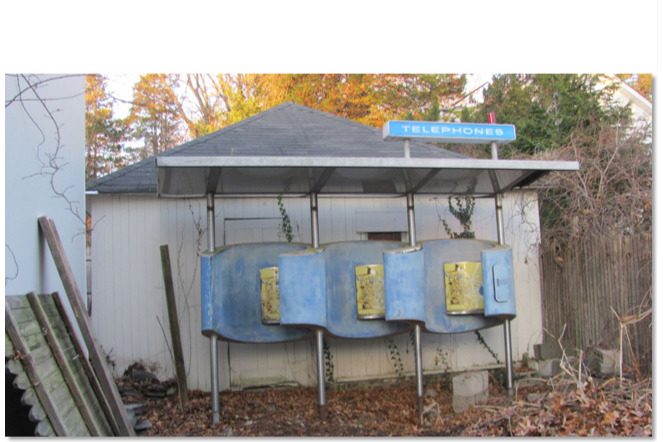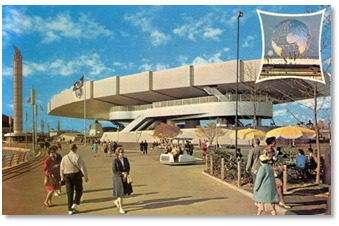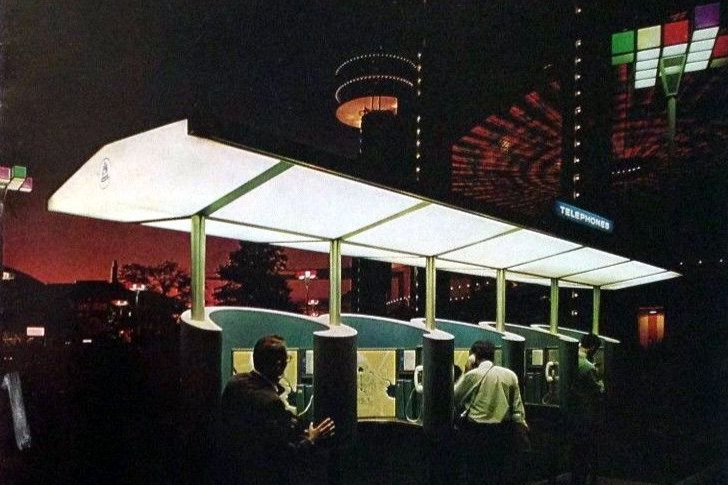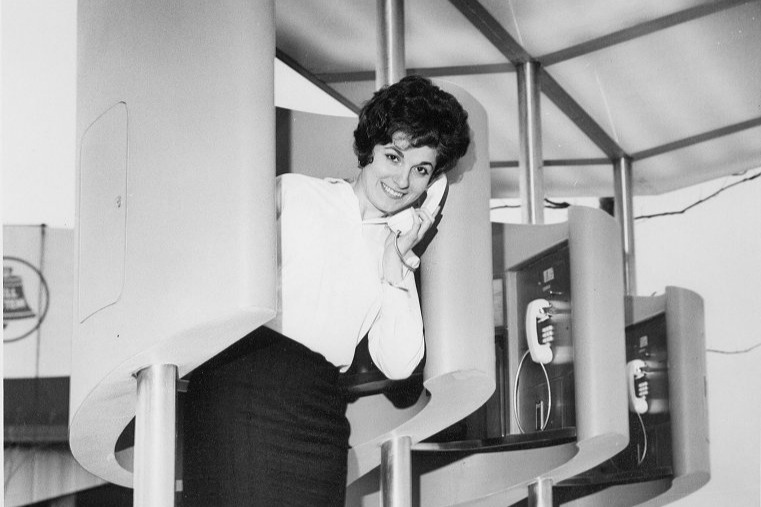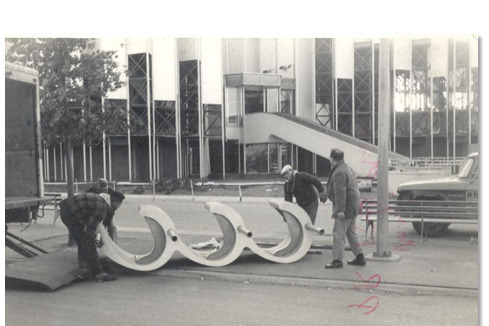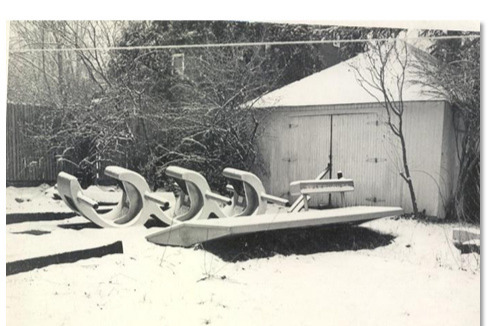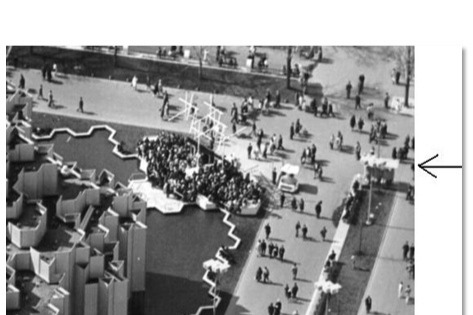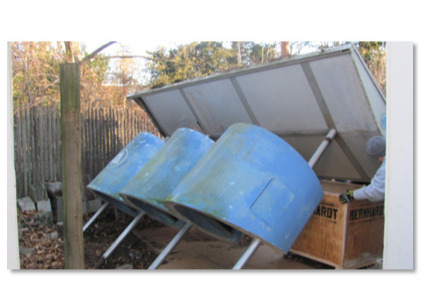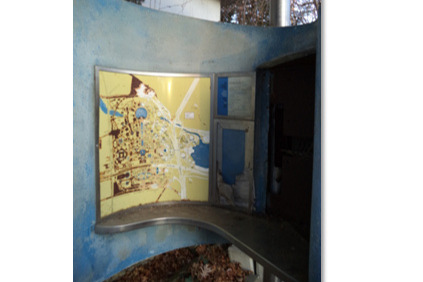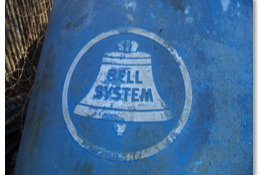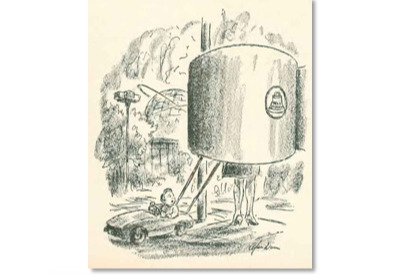| The New York World’s Fair Bell System Telephone Booth | |
|
Mitch Silverstein |
|
 |
|
|
THEN: The actual booth at the Fair* |
|
|
|
|
|
NOW: The last remaining booth today. Photo: Stephanie Bohn *** |
|
| We are trying to save this important piece of World's Fair, Communications and Mid Century Modern History! Please visit our gofundme site and donate to this worthy cause. Our goal is to restore and display this one-of-a kind phone booth. The only one known left in existence! | |
| BELL SYSTEM | |
|
|
|
|
Dexter Press postcard of the Bell Telephone Pavilion at the 1964-65 New York World's Fair |
|
|
The Bell System pavilion was one of the more popular destinations to visit at the 1964-65 New York World’s Fair. Communications technology was advancing rapidly in the mid ‘60’s and the company was growing. From the 1964 World’s Fair Guide Book: “The story of this breathtaking advance in communications is told visually in a 15-minute armchair ride in the giant "floating wing" that comprises the upper story of this pavilion. In a lower level, an exhibit hall is devoted to the technology of modern communications and its history of continuous development. The wing itself, 400 feet long, is covered with lightweight Fiberglas and rests on just four pylons. Next to it rises one of the tallest structures at the Fair, a 140-foot microwave tower through which TV shows originating at the Fair are transmitted.”(1) |
|
|
Besides showcasing technological advancements at the pavilion, Bell Systems was responsible for the communications at the fair. |
|
|
“We are determined that this World's Fair is going to have the best and most modern communications available anywhere in the world. For example, we are going to have about 10,000 telephones out here, we're going to have about 250,000,000 conductor feet of wire connecting these various telephones; included in the 10,000 are about 1700 public telephones and they are going to be the latest design.” Remarks by Clifton W. Phalen, president of the New York Telephone Company, Thursday, June 21, 1962 |
|
|
At the Fair, Bell Systems showcased the first Picture Phone which wowed audiences. There were Family Phone Booths which were private egg shaped kiosks where the whole family could make group phone calls to friends and relatives. Push Button phones were new but were the norm for the fair. All of the 1,400 public telephones were the modern TOUCH-TONE push button model, which make calling a faster, more conventional experience.(2) Besides the more conventional wall hung pay phones, patrons to the fair were excited to use the unique serpentine phone booths. |
|
| SERPENTINE PHONE BOOTHS | |
|
|
|
|
Luminous
canopies of white translucent Plexiglass light more than 100 outdoor
telephone stations at the Fair. |
|
|
World’s Fair Phone Booths Feature Push-Button Calling: A new style open air booth – one of several advanced designs being unveiled at the Fair – consists of units of three to five blue and white booths located at convenient spots around the fairgrounds. The Bell System calls them “serpentine” booths because of their swirling line design. (3) |
|
|
The serpentine booths were designed by American industrial designer Henry Dreyfuss. He was responsible for designing many desk and wall telephones between 1949 and 1972. He also designed the iconic Princess Phone in 1959. (4) |
|
|
|
|
|
The Serpentine booth is one of the Bell System innovations at the New York Worlds Fair. It features a Touch-Tone phone in each wavy coil [booth]. The model is Bell System Hostess Joan Solimine.(5) |
|
| PETER WARNER | |
|
Peter Warner worked as an archivist at a NYC architectural firm. He was inspired by his father, an architect, which helped design the site plans for the 1939 World's Fair. He was well known in the world’s fair collectors circle. Early on he was a collector and historian of World’s Fairs and President of the World's Fair Collectors Society. Collecting ''started out as my hobby, but it's not a hobby anymore,'' he said, ''one could say it's a mission. I'm doing it for the benefit of the future.’’ (6) Mr. Warner had the foresight, with permission, to grab what he could when the NY World’s Fair ended. Besides pallets full of guide books and other ephemera and souvenirs, he also grabbed a full size serpentine phone booth. He resurrected it next to his garage at his home in Rockland County, NY where it has resided since 1965 as an icon for the Warner family and their neighbors. |
|
|
|
|
|
Removing the booth from the fairgrounds in
1966. Tower of Light Pavilion in the background already in a state of
demolition. |
|
|
|
|
|
The booth in Peter Warner’s driveway awaiting
installation to the right of the garage pictured. |
|
| LOCATION OF THE BOOTH AT THE FAIR | |
| The booth was located at the intersection of the Court of the Universe and the Avenue of Commerce between the Tower of Light and General Electric. | |
|
|
|
|
Photo: Bill Young Collection |
|
|
|
|
|
Photo: Bill Young Collection |
|
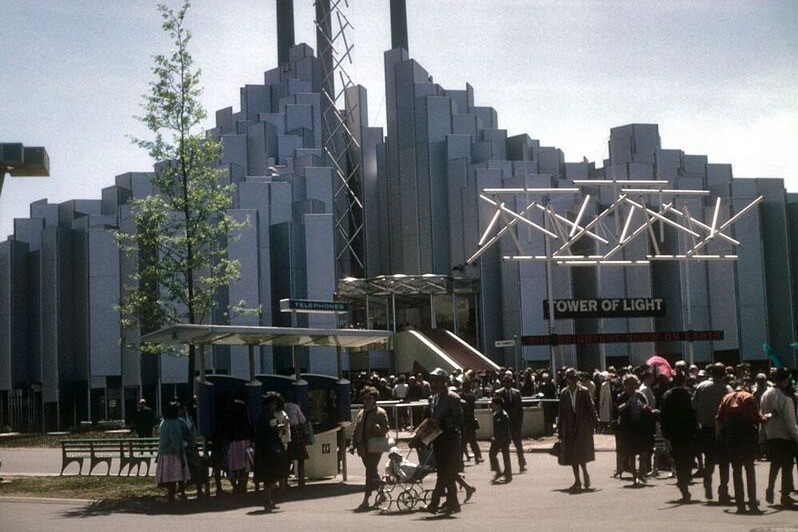 |
|
|
Photo: Bill Young Collection |
|
 |
|
|
Photo: Bill Young Collection |
|
| CURRENT BOOTH | |
|
The New York World’s Fair Phone Booth is known to be the only one left in existence. |
|
|
This booth also has an emergency call box, a phone located behind a small door that would be a direct dial to security. A red light on the roof top Telephone sign would light up when this phone was activated. |
|
|
This booth held three stainless steel push button phones with white handsets and three enamel maps of the fair. The original phone books and maps are still present. |
|
|
After fifty two years the booth has been generously donated, by the latest owners, Bruce and Thayer Woodcock, to the Queens Museum in Flushing Meadows Corona Park, Queens, NY. It’s coming back to its origins. Mitch Silverstein, a NYWF collector, historian and co-founder of the New York State Pavilion Paint Project has been in contact for years with the Woodcock’s and visited the booth several times to document its history. When the time was right, the booth was relocated to the museum with a grant from the National Trust for Historic Preservation. Now in protective storage at the museum, plans will be underway to determine a course for restoration and fundraising. We hope to have the booth on display in the future for all to enjoy. It not only represents Mid-Century Modern Design, the New York World’s Fair 1960’s technology, nostalgia and innovation, it represents a critical time in history and an event that shaped NYC and those who attended. |
|
|
|
|
|
Photo: Mitch Silverstein *** |
|
|
|
|
|
Photo: Stephanie Bohn *** |
|
|
|
|
|
Photo: Mitch Silverstein *** |
|
|
|
|
|
Photo: Mitch Silverstein *** |
|
|
See Photos of the booth from 2006 HERE |
|
| References | |
|
* Cropped
photo: Bill Cotter Collection
www.worldsfairphotos.com
*** New York State Pavilion Paint Project http://nyspproject.org |
|
| 1. Official Guide New York World’s Fair 1964/1965, Time-Life Books, 1964 | |
| 2. From World’s Fair Brochure- “Fun at the Fair…where and how to find it” | |
3. Undated press release from: JOSEPH P. CROTTY BELL SYSTEM EXHIBIT
NEW YORK WORLD'S FAIR World's Fair, New York |
|
| 4. Wikipedia- Henry Dreyfuss: https://en.wikipedia.org/wiki/Henry_Dreyfuss | |
|
5. Bell System History: http://www.beatriceco.com/bti/porticus/bell/miscellaneous.html |
|
| 6. The New York Times November 13, 1988: http://www.nytimes.com/1988/11/13/nyregion/world-s-fair-buffs-gather-in-queens.html | |
|
Special Thanks to: Bruce and Thayer Woodcock; Louise Weinberg and Arnold Kaye: Queens Museum; Jason Clement: National Trust for Historic Preservation; Bernhardt Moving and Storage, Pearl River, NY. |
|
| With great effort from the New York State Pavilion Paint Project nyspproject.org | |
|
|
|
|
From the October 3, 1964 issue of The New Yorker |
|
| Back to: New York State Pavilion Paint Project | New York Worlds Fair Carousels and Collection | |
| Copyright M. Silverstein 2019 | |
